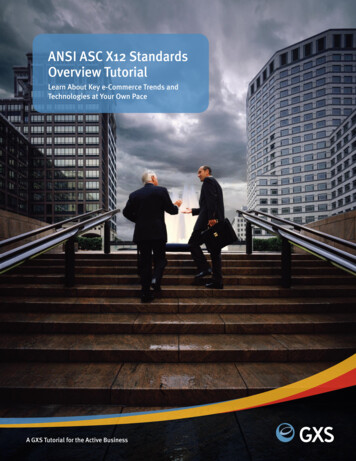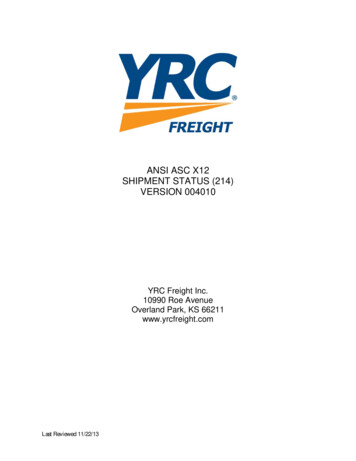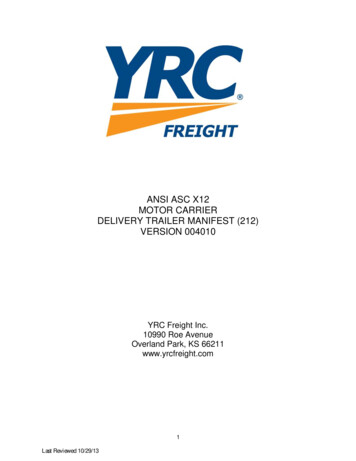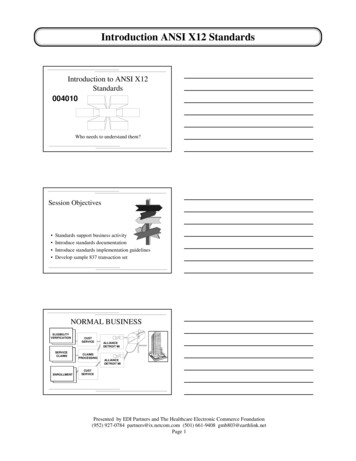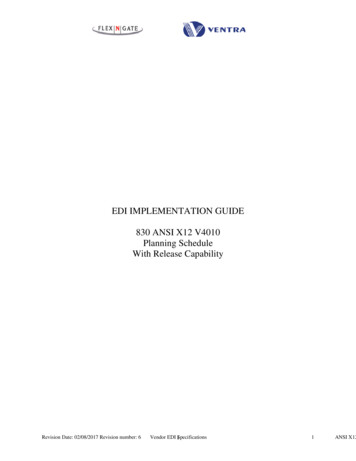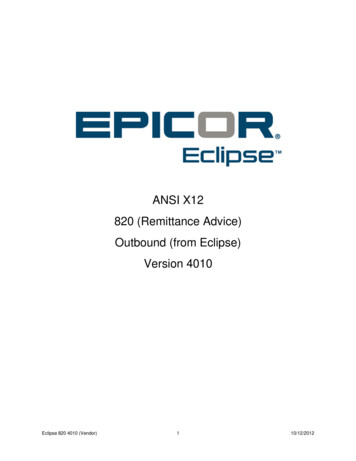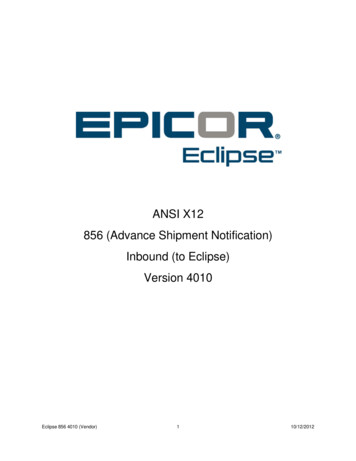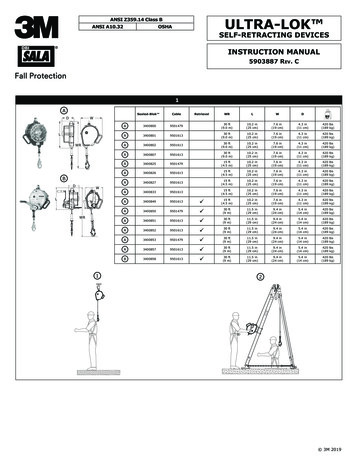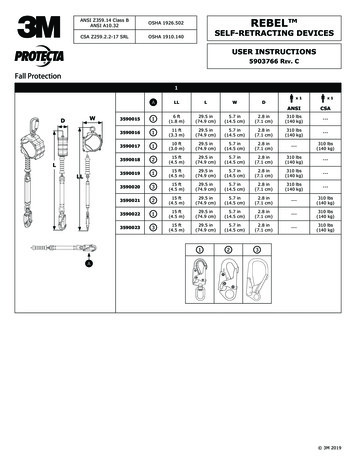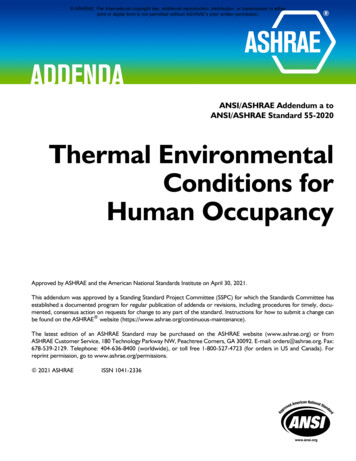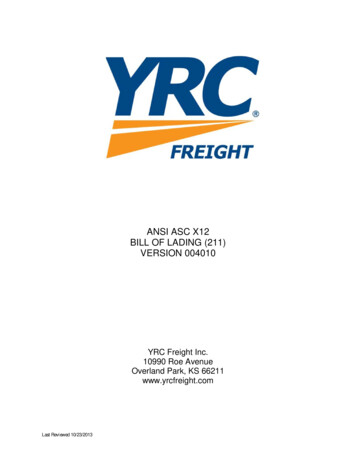
Transcription
ANSI ASC X12BILL OF LADING (211)VERSION 004010YRC Freight Inc.10990 Roe AvenueOverland Park, KS 66211www.yrcfreight.comLast Reviewed 10/23/2013
Dear YRC Freight Customer:Thank you for your interest in trading electronic bills of lading with YRC Freight.implementation guide you requested.This is the 211We look forward to working with you to implement the EDItransaction set 211. If you have any questions about the 211 or any other EDI issues, please feel free tocontact edihelp@yrcfreight.com.Last Reviewed 10/23/2013ii
PrefacePurpose and ScopeThe purpose of this guide is to provide YRC Freight trading partners the necessary information to createand transmit Bills of Lading, using EDI, to YRC Freight. The material presented here covers the 211transaction set of Version 004 Release 010 of the ANSI ASC X12 standard. This transaction set can beused to allow shippers or other parties responsible for contracting with a motor carrier to provide a legalBill of Lading for a shipment. It is not to be used to provide a motor carrier data relative to a load tender,pick-up manifest or appointment scheduling. Contact YRC Freight for information on the other standardsand versions supported.American National Standards Institute Accredited Standards Committee X12YRC Freight uses ANSI ASC X12 standard-format transaction sets to exchange electronic documentswith its EDI trading partners.YRC Freight is a leader in the use of EDI in the transportation industry and firmly supports the use of ANSIASC X12 standards in EDI trading partner relationships. The use of such standards cultivates a commonlanguage between trading partners and expedites EDI setup. A well-developed EDI system providesnumerous possibilities for expanding the business relationship.Last Reviewed 10/23/2013iii
TABLE OF CONTENTSPREFACEIIIPurpose and ScopeiiiANSI ASC X12iiiREFERENCE MATERIAL1ASCX12 Publications1ATA Publications1BILL OF LADING (211) DATA REQUIREMENTS2ELECTRONIC DATA INTERCHANGE (EDI)3Communications3The Structure of an Electronic Transmission4Transaction Structure5NOTATION CONVENTIONS6Segment Requirements6Element Requirements6Data Types6Data Element Reference Number7TRANSACTION SET 2118Header Segments8Detail Segments9211 BUSINESS EXAMPLES10Freight Not Palletized11Freight Palletized With One Commodity13Freight Palletized With Mixed Commodities15Freight Palletized With Mixed Commodities and Loose Cartons18Last Reviewed 10/23/2013iv
Freight Palletized With Cartons Containing Mixed Commodities and Loose Cartons ContainingMixed Commodities21Freight Palletized With Mixed Commodities and Loose Cartons22Freight Palletized With Mixed Commodities and Loose Cartons23Hazardous Material Loop 0230 and 023124SEGMENT DEFINITIONS25ISA Interchange Control Header25IEA Interchange Control Trailer27GS Functional Group Header28GE Functional Group Trailer29ST Starting Segment30BOL - Beginning Segment for the Motor Carrier Bill of Lading31B2A Set Purpose33MS3 Interline Information34MS2 Equipment or Container Owner and Type35L11 Business Instructions and Reference Number36G62 Date/Time37AT5 Bill of Lading Handling Requirements38K1 Remarks39N1 Name40N2 Additional Name Information42N3 Address Information43N4 Geographic Location44G61 Contact45AT1 Bill of Lading Line Item Number46L11 Business Instructions and Reference Number47AT3 Bill of Lading Rates and Charges48AT4 Bill of Lading Description50Last Reviewed 10/23/2013v
AT2 Bill of Lading Line Item Detail51MAN Marks and Numbers53SPO Shipment Purchase Order Detail55LX Assigned Number57MAN Marks and Numbers58SPO Shipment Purchase Order Detail60G61 Contact62L11 Business Instructions and Reference Number63LH6 Hazardous Certification64LH1 Hazardous Identification Information65LH2 Hazardous Classification Information67LH3 Hazardous Material Shipping Name68LFH Free-Form Hazardous Material Information69LEP EPA Required Data70LH4 Canadian Dangerous Requirements71LHT Transborder Hazardous Requirements73L11 Business Instructions and Reference Number74SE Transaction Set Trailer75Last Reviewed 10/23/2013vi
Reference MaterialASCX12 PublicationsElectronic Data Interchange X12 Standards reflecting Version 004 Release 010 (004010), datedDecember 1997. This publication is available from DISA, 1800 Diagonal Road, Suite 200, Alexandria, VA22314, (703) 548-7005, www.disa.org.ATA PublicationsAmerican Trucking Association’s Motor Carrier Industry Guide to Electronic Data InterchangeImplementation and Conventions, reflecting Version 004 Release 010 (004010), dated July 1996. Thispublication is available from the American Trucking Association’s Information Technology Council, 2200Mill Road, Alexandria, VA 22314, (703) 838-1721.Last Reviewed 10/23/20131
Bill of Lading (211) Data Requirements The 211 must be used as a bill of lading with complete shipment information. The 211 is NOT to beused as a load tender to notify YRC Freight a shipment is available. YRC Freight prefers ALL bills of lading shipped with YRC Freight to be transmitted electronically.Because of system constraints, we understand this is not always possible, and only shipmentsdestined to certain consignees can be sent. The bill of lading must be transmitted within one hour of the YRC Freight trailer leaving the shippingdock. (It can be transmitted up to five days before if the shipment information is accurate). Thisensures the data will be available to the terminal when the freight arrives. YRC Freight only accepts an original bill of lading. Corrections and cancellations are handled manuallyat the terminals. YRC Freight traces and bills all shipments by PRO number. YRC Freight has a process called prePROs, which gives shippers the opportunity to store PRO numbers in their systems and assign thembefore transmitting. This gives a shipper control over the PRO number assigned to a bill of ladingnumber, which makes tracing and billing control more efficient. Check with your local YRC Freightsales representative for a block of PRO numbers. It is mandatory that an electronic bill of lading provide YRC Freight an actual street address for shipperand consignee information. YRC Freight cannot pickup or deliver from/to a post office box.The following details are mandatory in the electronic bill of lading: The YRC Freight SCAC - RDWY.Shipment Terms - Code identifying payment terms for transportation charges.Pickup Date - The pickup date is the date YRC Freight picks up the shipment.Bill of Lading Number - Customer’s shipment identification number.YRC Freight’s PRO Number - This field is preferred, but YRC Freight can assign if necessary.Transaction Set Purpose Code - Always a ‘00’ for an original bill of lading .All Special Handling Requirements - Examples include notify contact before delivery, inside deliveryrequired, lift gate required at destination, etc. Shipper Information - Shipper name, shipper identification code assigned by the shipper or provided byYRC Freight, shipper address (no P.O. boxes), shipper city, state and ZIP. Consignee Information - Consignee Name, consignee address (where YRC Freight will deliver theshipment), consignee city, state and ZIP, and consignee contact information for delivery appointments. Third-Party Information - Whenever a third party is paying the freight charges, the information for thethird party must be supplied (name, address, city, state and ZIP).The following information is required for each commodity (line item): Bill of Lading Line Item Number - This is a sequential number beginning with 1 to identify each line itemprovided. Lading Description - This is a text description of the commodity being shipped. Lading Quantity - Number of handling units for which the carrier is responsible (master handling units).If the master handling unit is pallets, then pallet information must be provided. Lading Package Form Code - The type of package being shipped (e.g., CTN, PLT, SKD, etc.). Weight Qualifier - Identifies the weight of the commodity as net weight, tare weight, etc. Weight - The weight of the commodity being shipped. If the commodities are palletized, the carton information must also be provided (quantity and packageform code). The NMFC Number (National Motor Freight Classification code) - This number can be obtained fromyour traffic department or from your local YRC Freight Sales representative. Purchase Order information - The PO number, PO department, total carton count for the PO on thisshipment and the total weight for the PO on this shipment. Hazardous Information for all hazardous commodities - The UN/NA identification code, hazardousmaterial shipping name and hazardous-material technical name.Last Reviewed 10/23/20132
Electronic Data Interchange (EDI)CommunicationsYRC Freight Inc. has developed a communication network that gives our trading partners the ability totransmit EDI transactions directly to YRC Freight. This method is preferred by YRC Freight.If your communications do not support bisynchronous communications, then a third party Value-AddedNetwork must be used.Last Reviewed 10/23/20133
The Structure of an Electronic TransmissionAn EDI transmission consists of one or more “envelopes,” which identify the sender and receiver of atransaction set. ISA and IEA segments mark the beginning and the end of an envelope, respectively. Inthe envelope, the transactions sets are organized into one or more functional groups bounded by a GSand a GE segment. Figure 1 illustrates the format of an EDI transmission.Communication ProtocolISAInterchange HeaderGSGroup HeaderSTTran HeaderTran DetailSETran TrailerGEGroup trailerGSGroup HeaderSTTran HeaderTran DetailSETran TrailerGEGroup TrailerIEAInterchange TrailerCommunication ProtocolFigure 1: Transmission StructureLast Reviewed 10/23/20134
Transaction StructureEDI transaction sets consist of a group of segments (records) arranged in a specific order. Mosttransactions have header-level segments and detail-level segments. There can also be repeated sets ofsegments referred to as loops. Each segment begins with a segment identifier and ends with a segmentterminator. The segment terminator is a special character agreed on by sender and receiver to define theend of a segment. The most commonly used segment terminator is the hexadecimal ‘15’. Data elements(fields) in a segment are delimited by an element separator. The element separator is a special characteragreed on by sender and receiver. The most commonly used element separator is an asterisk (*), ahexadecimal ‘5C’.STTransaction HeaderHeader SegmentsDetail SegmentsSummary SegmentsSETransaction trailerFigure 2: Transaction StructureLast Reviewed 10/23/20135
Notation ConventionsSegment Requirements (M) MANDATORY: The segment must be transmitted. (O) OPTIONAL: The segment may be transmitted if so desired.Element Requirements (M) MANDATORY: The data element must be transmitted. (O) OPTIONAL: The data element may be transmitted if so desired. (X) RELATIONAL: The data element's existence or absence is related to the existence or absence ofanother data element. The relationship is explained by a note after the segment definition. There couldalso be an alphabetic code to explain the relational condition. (C) CONDITIONAL: The data element must be transmitted under certain conditions. (P) PAIRED or MULTIPLE: If any element is transmitted, then all must be transmitted. (R) REQUIRED: At least one of the data elements specified must be transmitted. (E) EXCLUSION: Not more than one of the data elements specified can be transmitted. (L) LIST CONDITIONAL: If the first data element specified is transmitted, then at least one of the othersmust be transmitted. Any or all elements not specified as the first may be transmitted with the first dataelement. Each data element has a minimum and maximum length requirement. In a mandatory numeric data element, the minimum characters, as defined in the data dictionary, mustbe transmitted even if the value is zero.Data Types AN: Alphanumeric data elements containing the numerals 0–9, the characters A–Z and any specialcharacters except asterisk (*), the greater-than sign ( ) and characters with a hexadecimal value of ‘40’ orless. These characters are control characters and should not be used for data. The contents are leftjustified. Trailing spaces should be suppressed unless necessary to satisfy a minimum lengthrequirement. R: (Real) numeric data containing the numerals 0–9 and a decimal point in the proper position. Thedecimal point is optional for integer values but required for fractional values. A leading or - sign may beused. The minus sign must be used for negative values. Nn: Numeric data containing the numerals 0–-9, and an implied decimal point. The 'N' indicates that theelement contains a numeric value and the 'n' indicates the number of decimal places to the right of theimplied decimal point. The actual decimal point is not transmitted. A leading or - sign may be used. Theminus sign must be used for negative values. Leading zeroes should be suppressed unless they arenecessary to satisfy a minimum number of digits required by the data-element specification. For a dataelement defined as N4 with a minimum length of 4, the value 0.0001 would be transmitted as ‘0001’. Foran N4 data element with the minimum length of 1, the value 0.0001 would be transmitted ‘1’. ID: A data element identifier from a pre-defined list of values maintained by ASC X12. DT: Numeric date in the form CCYYMMDD. TM: Numeric time in the form HHMM. Time is represented in 24-hour-clock format.Last Reviewed 10/23/20136
Data Element Reference NumberThe Data Element Reference Number is a unique identifier used to help find data element definitions inthe applicable standards manual.Last Reviewed 10/23/20137
Transaction Set 211 Motor Carrier Bill of LadingThis transaction set can be used to allow shippers or other parties responsible for contractingwith a motor carrier to provide a legal bill of lading for a shipment. It is not to be used to providea motor carrier data relative to a load tender, pickup manifest or appointment scheduling.Header ransaction Set HeaderBeginning SegmentSet PurposeInterline InformationEquipment or Container Owner and TypeBusiness Instructions and Reference NumberDate/TimeBill of Lading Handling G61NameAdditional Name InfoAddress InformationGeographic LocationContactMOMMO11213Last Reviewed Loops10
Detail 1L11AT3AT4Bill of Lading Line Item NumberBusiness Instructions & Reference NumberBill of Lading Rates and ChargesBill of Lading OBill of Lading Line Item DetailMarks and NumbersShipment Purchase Order d NumberMarks and NumbersShipment Purchase Order ontactBusiness Instructions & Reference NumberHazardous LHTL11Hazardous Identification InformationHazardous Classification InformationHazardous Material Shipping NameFree-Form Hazardous Material InformationEPA-Required DataCanadian Dangerous RequirementsTransborder Hazardous RequirementsBusiness Instructions & Reference 31023125SETransaction Set TrailerM1Last Reviewed 10/23/20139
211 Business Examples Version 004010Definitions:The following examples use an excerpt of an actual printed copy of a Bill of Lading. The columns aredefined as follows:H/U Count - Represents the number of Handling Units the carrier handles, e.g., if the shipment has twopallets containing 20 cartons, the number of handling units is two (pallet count)H/U Type - Type of package the carrier is handling, e.g., Pallets, Skids, Slip Sheets, Cartons, Pieces.etc.Unit Count - This column will be used only when the Handling unit type is pallet, skid or slip sheets. Thiscolumn represents the number of pieces contained on the pallet, skid or slip sheet.Unit Type - Package form code for the units contained on the H/U Type. e.g., Pieces, cartons, etc.Description - Text description of the commodity being shipped.NMFC Number - National Motor Freight Classification Code - The National Motor Freight TariffAssociation assigns this number. It is unique for each commodity.Weight - Total weight for the line item.Assumptions:Commodity 1Commodity 2Commodity 31 palletweighs 42 poundsweighs 24 poundsweighs 42 poundsweighs 40 poundsLast Reviewed 10/23/201310
Example 1 Freight Not PalletizedH/U CountH/UTypeUnitCountUnit Type5CTNPO iption of ArticleNM FCNumberCommodity 1999999-01Weight210Carton I d’s contained on the shipping 93104This is the simplest of all the examples. This shipment has five cartons of commodity 1, weighing 210pounds, and is identified by NMFC number 999999-01. The shipment contains two purchase orders, 123and 456. PO 123, going to department 1144, contains two cartons and weighs 84 pounds. PO 456, alsogoing to department 1144, has three cartons and weighs 126 pounds. The bar codes listed correspond tothe five cartons on the shipment. Notice that there is no unit count or type because the handling unit wasnot a pallet, skid or slip sheet.Last Reviewed 10/23/201311
Example 1 cont’ dFreight Not PalletizedST*211*000010001 N/LBOL*RDWY*PP*12345*19970501**1231234561 N/LB2A*00 N/LMS2*RDWY*123456 N/LN1*SH*SHIPPER NAME*93*123456789 N/LN3*9999 SHIPPER STREET*ADDITIONAL ADDRESS LINE N/LN4*SHIPPER CITY*ST*00000 N/LN1*CN*CONSIGNEE NAME N/LN3*9999 CONSIGNEE STREET*ADDITIONAL ADDRESS LINE N/LN4*CONSIGNEE CITY*ST*99999 N/LG61*DC*DELIVERY CONTACT NAME*TE*(888)999-9999 N/LAT1*1 N/LL11*999*AE N/LAT4*COMMODITY 1 N/LAT2*5*CTN*N*L*210****999999-01 N/LMAN*GM*00000858050113093100 N/LMAN*GM*00000858050113093101 N/LMAN*GM*00000858050113093102 N/LMAN*GM*00000858050113093103 N/LMAN*GM*00000858050113093104 N/LSPO*123*1144*CT*2*L*84 N/LSPO*456*1144*CT*3*L*126 N/LSE*23*000010001 N/LThis example shows how freight not palletized would be mapped in an EDI 211 document. Loops 0200and 0210 are used to define the line items. In this example, there is only one commodity. Therefore, thereis only one occurrence of each loop. The MAN and SPO segments are used in loop 0210 because theyare directly associated with the commodity described in the AT1*1.Loop 0220 is used only when the marks and numbers or the purchase order information cannot be directlyassociated with the line item, for example, when multiple commodities (line items) are used to fill onepurchase order. An example of this will be given later in the mixed commodities example. The marks andnumbers normally associate with only one line item, therefore, they will be placed in the 0210 loop alongwith the rest of the commodity information.Last Reviewed 10/23/201312
Example 2 Freight Palletized With One CommodityH/U CountH/UTypeUnitCountUnit Type2PLT5CTNPO iption of ArticleNM FCNumberCommodity 1999999-01Weight210Carton I d’s contained on the shipping label0010085805011309320000100858050113093201This shipment contains one commodity that has been palletized. Therefore, when the Bill of Lading isprinted, it will show two handling units (pallets), which is what the carrier picks up and is responsible for.On those two pallets are five cartons of commodity 1, NMFC number 999999-01, for a total weight of 210pounds. One commodity is split between purchase order number 123, which contains two cartons going todepartment 1144, weighing 84 pounds. The second purchase order, 456, also going to department 1144,contains three cartons, weighing 126 pounds. The two bar c
Oct 23, 2013 · American Trucking Association’s Motor Carrier Industry Guide to Electronic Data Interchange Implementation and Conventions, reflecting Version 004 Release 010 (004010), dated July 1996. This publication is available from the American Trucking Association’s Information Technology Counc
